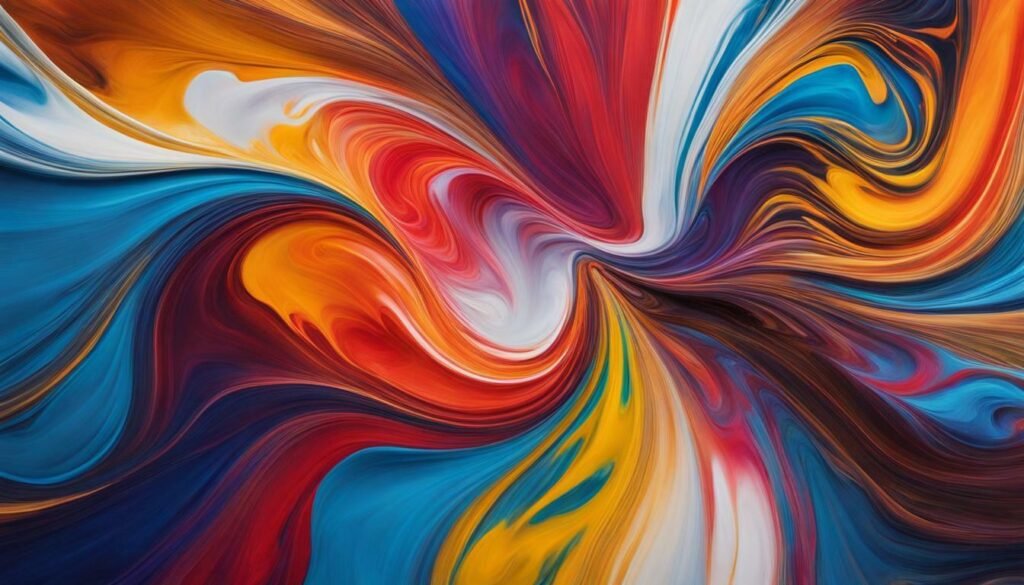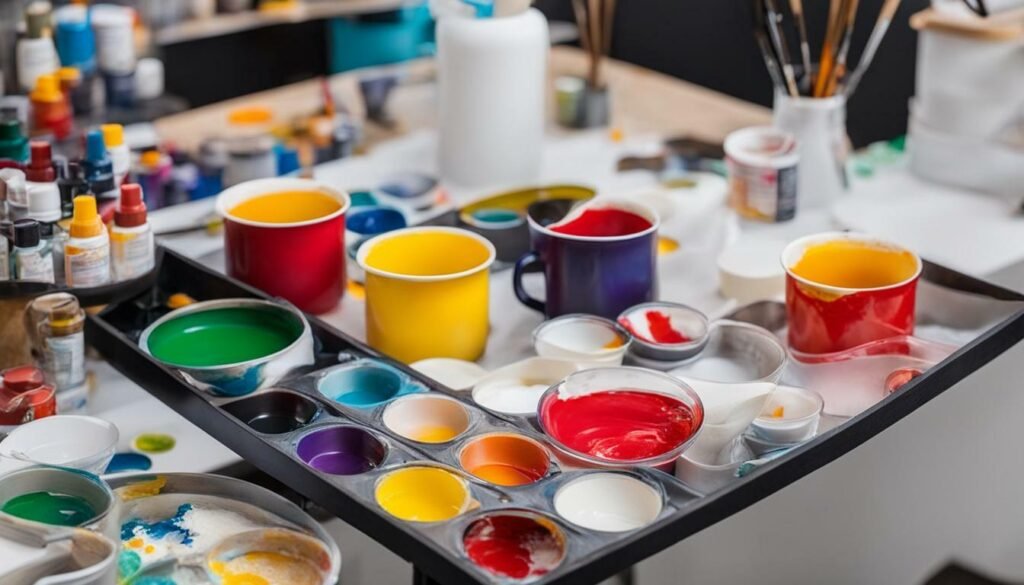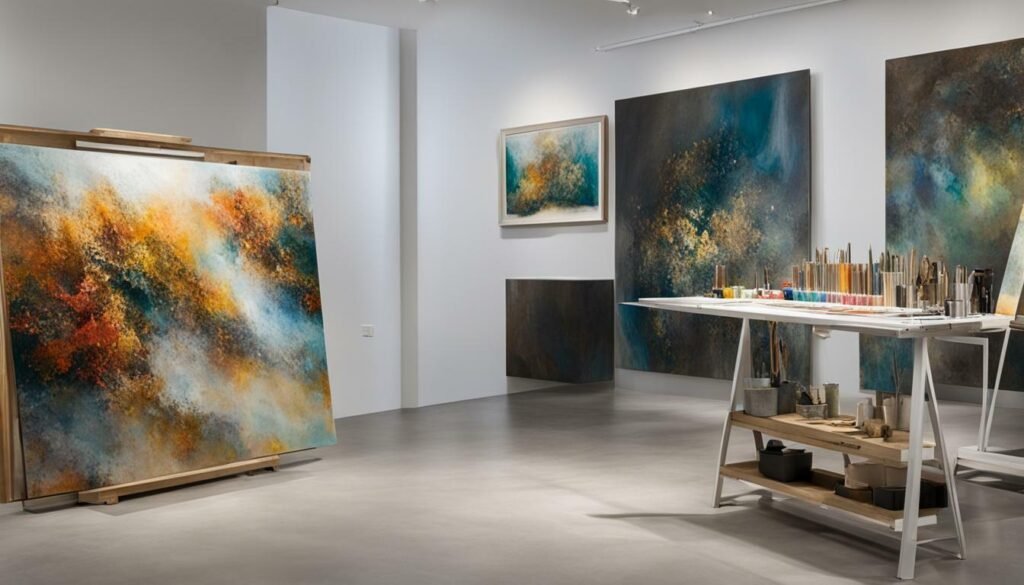Welcome to our comprehensive guide on Acrylic Pouring Art, also known as fluid art.
Whether you’re a beginner or experienced artist, this guide will help you perfect your acrylic pouring skills and unlock your inner creativity.
- Acrylic Pouring Art involves pouring different colors of acrylic paint onto a canvas to create unique and vibrant compositions.
- Gathering essential supplies such as acrylic paints, pouring medium, canvas, mixing cups, stirring sticks, and a protective surface are crucial for a successful acrylic pouring session.
- Preparing your workspace properly will create a clean and conducive environment for your artistry.
- Choosing the right acrylic paints, understanding pouring mediums, mixing your colors, exploring different pouring techniques and creating cells are essential tips to perfect your acrylic pouring skills.
- Once your acrylic poured artwork is complete, allow it to dry thoroughly and consider applying a varnish or resin coating to protect and enhance the vibrancy of your finished piece.
What is Acrylic Pouring Art?
Acrylic Pouring Art, also known as fluid art, is a contemporary form of abstract painting that involves pouring various colors of acrylic paint onto a canvas to create mesmerizing compositions. This technique allows the paint to flow and mix together, resulting in stunning fluid patterns and textures.

- The technique originates from the 1930s when it was called “Liquid Pouring.”
- Acrylic Pouring Art has gained popularity in recent years due to its versatility and unique results.
- This art form can be done by artists of all skill levels, making it a great introduction to the world of painting.
Essential Supplies for Acrylic Pouring
Before you begin your acrylic pouring journey, make sure to gather all the necessary supplies. Here are the essentials:
- Acrylic Paints: Choose fluid or soft body acrylic paints with high pigment load and good flow.
- Pouring Medium: Additives that help thin and extend the acrylic paint.
- Canvas: Choose the appropriate canvas size for your project.
- Mixing Cups: Use separate cups for each color.
- Stirring Sticks: Gently stir the paint and pouring medium together.
- Protective Surface: Cover your workspace with a plastic sheet or drop cloth to avoid unwanted spills and stains.
Investing in these supplies will set a solid foundation for creating beautiful acrylic pouring art. Get ready to unleash your creativity!

Before diving into the fun of creating your acrylic pouring art masterpiece, it is crucial to prepare your workspace properly. The following steps will help you get started:
- Clear any clutter from your work area to create an open and organized space.
- Protect your work surface by laying down a plastic sheet or a drop cloth to catch any drips or spills. This will also make cleaning up more manageable.
- Keep your essential supplies organized and within reach. Arrange them in a logical order, so you don’t scramble around searching for the items you need.
- Wear protective clothing such as an apron or old clothes to avoid spoiling your favorite outfit.
By following these simple steps, you can set yourself up for a successful and enjoyable acrylic pouring experience.

When it comes to acrylic pouring, selecting the right paints can make all the difference in achieving your desired outcome. Fluid or soft body acrylic paints work best since they have a high pigment load and good flow, allowing the colors to blend smoothly on the canvas. It’s best to avoid heavy body acrylics as they tend to be too thick and may hinder the paint’s flow.
- Opt for fluid or soft body acrylic paints
- Choose paints with a high pigment load and good flow
- Avoid heavy body acrylics as they may inhibit the flow of the paint
When selecting colors, choose shades that complement each other and that you envision blending well together. It’s helpful to have a good selection on hand so you can experiment with different color combinations.
Remember, don’t be afraid to mix and match colors – the possibilities are endless!
Understanding Pouring Mediums
To achieve the desired consistency for pouring, you will need to use a pouring medium in combination with your acrylic paint. Pouring mediums are specialized additives that help to thin and extend the paint, allowing it to flow and mix together. There are different types of pouring mediums available, and each one can produce unique effects in your acrylic pouring art. Here are some common pouring mediums:
- Silicone Oil: Adding a few drops of silicone oil to your mixture creates cells in your artwork.
- Alcohol: Adding a small amount of alcohol can create texture and a unique look in your acrylic pouring art.
- Water: Water can be used to thin out the acrylic paint, but be careful not to add too much, as this can result in cracking or other issues.
It’s important to use a pouring medium that is compatible with your chosen acrylic paint and the desired pouring technique. Be sure to follow the instructions on your pouring medium carefully to achieve the best results.

Mixing your acrylic pouring colors is a fun and experimental process that allows you to create stunning compositions. Follow these tips to achieve the perfect hues and avoid common mistakes:
- Use separate containers for each color to prevent contamination and to mix the right amount of paint for your project.
- Add pouring medium to your acrylic paint and mix gently to achieve a smooth, even consistency.
- Experiment with different color combinations to create unique and eye-catching compositions. Start with a few complementary colors and gradually add more to your palette.
- Avoid overmixing the paint, as this can create small bubbles in the mixture that may affect the final result.
Remember, the key to mixing your acrylic pouring colors is to have fun and experiment to find your own unique style.

There are several pouring techniques you can explore in acrylic pouring art. Some popular techniques include:
- Dirty Pour: This technique involves layering different colored paints into a cup, then pouring the mixture onto the canvas in one swift motion. The colors will mix and blend together to create a unique composition.
- Flip Cup: The flip cup technique starts by pouring different colors of paint into a cup, then placing the cup upside down onto the canvas and lifting it up to let the paint pour out. This technique can create a beautiful and unexpected color flow.
- Swipe: This technique involves pouring paint onto the canvas in straight lines, then swiping a tool, such as a piece of cardboard, across the canvas to create fluid designs.
- Tree Ring Pour: This technique is created by pouring a ring of paint onto the canvas, then using a tool, such as a straw or skewer, to create a tree-like pattern.

Each technique offers unique results, so don’t be afraid to experiment and find your preferred style. With practice and experimentation, you’ll be able to create mesmerizing compositions and unlock your inner artist.
Tips for Creating Cells in Acrylic Pouring
Cells are a fascinating effect that can add depth and interest to your acrylic pouring art. Here are some tips for creating cells:
- Use a silicone oil or dimethicone to increase the likelihood of cells forming.
- Apply the silicone in small amounts, as too much can cause the cells to become too large or overpowering.
- Use a torch to pop any air bubbles and encourage cell formation.
- Experiment with the placement of the silicone to create varied cell shapes and sizes.

After completing your mesmerizing acrylic pouring art, it’s important to let it dry thoroughly. Depending on the thickness of the paint, this process can take anywhere from 24 hours to several days. To prevent dust or debris from settling on your artwork while it dries, cover it with a clean and dry cover.
Once the artwork is fully dried, you can choose to leave it as is or apply a protective coating. A popular option is to use a varnish or resin coating to protect the paint and enhance the vibrancy of the finished piece. Be sure to use a brush or tool that won’t leave brush marks or bubbles.
If you plan to hang your artwork, add a wire or hardware to the back of the canvas. Consider framing or mounting the painting to give it an elegant and finished look.
Remember that each acrylic pouring art piece is unique and beautiful in its own way. Embrace your inner artist, experiment with different colors and techniques, and display your artwork with pride!

Acrylic pouring can be a fun and rewarding experience, but sometimes unexpected issues can arise. Fear not! Here are some common problems you may encounter and how to troubleshoot them:
- If your artwork cracks after drying, it may be due to either too much paint or the paint being too thin. Try using less paint next time or adding more pouring medium to your paint mixture.
- If you notice color fading after drying, it could be due to the quality of the paint. Opt for higher quality, lightfast acrylic paints or consider using a UV-resistant varnish or sealer.
- Uneven drying can occur if the paint is too thick or if the room temperature and humidity are not suitable for acrylic pouring. Ensure the room is well-ventilated and has a consistent temperature. You can also add a drying agent to your paint mixture or use a hairdryer to speed up the drying process.
Remember, every artist experiences challenges, but with our troubleshooting tips, you can overcome them and create beautiful acrylic pouring art!

Now that you’ve created your stunning acrylic pouring art, it’s time to showcase it for the world to see. Here are some tips for displaying and sharing your artwork:
- Frame your artwork: Put your acrylic pouring art in a frame to give it a polished look. Choose a simple frame that does not detract from the art itself.
- Create a gallery wall: Hang multiple pieces of your acrylic pouring art on a single wall to create a striking and cohesive gallery space.
- Share on social media: Use Instagram, Facebook, or Pinterest to share photos of your artwork and connect with other artists and enthusiasts.
- Participate in art shows: Look for local art shows or galleries to display and sell your artwork. This can help you gain exposure and potentially sell your pieces.
Remember, displaying and sharing your acrylic pouring art is a great way to inspire others and showcase your creativity. So don’t be afraid to share your mesmerizing artwork with the world!

Congratulations on completing this fluid art masterclass! You are now equipped with the knowledge and skills to create mesmerizing acrylic pouring artwork. Here are some additional tips and inspiration to take your artistry to the next level:
- Experiment with different pouring techniques and color combinations to find your preferred style.
- Try incorporating other materials, such as glitter, beads, or even natural elements like leaves or flowers, to add texture and dimension to your artwork.
- Don’t be afraid to make mistakes! Sometimes the most beautiful pieces come from unexpected surprises.
- Join online communities or attend local workshops to connect with other artists and learn new techniques.
- Find inspiration in the world around you – from nature or other artistic mediums like music, literature, or film.
- Remember to have fun and let your creativity flow!
Acrylic pouring art is a limitless and captivating form of expression. With these tips and inspiration, you have the tools to create stunning masterpieces and continue to hone your craft. Happy pouring!
FAQ
What is Acrylic Pouring Art?
Acrylic Pouring Art is a form of abstract painting that involves pouring different colors of acrylic paint onto a canvas to create unique and vibrant compositions. This technique allows the paint to flow and mix together, resulting in stunning fluid patterns and textures.
What supplies do I need for Acrylic Pouring?
Before you begin your acrylic pouring journey, it’s important to gather the essential supplies. These include acrylic paints, pouring medium, canvas, mixing cups, stirring sticks, and a protective surface to catch any drips or spills.
How do I prepare my workspace for Acrylic Pouring?
To ensure a successful acrylic pouring session, it’s crucial to prepare your workspace properly. Clear any clutter, lay down a plastic sheet or drop cloth, and set up your supplies in an organized manner. This will create a clean and conducive environment for your artistry.
How do I choose the right acrylic paints for pouring?
Selecting the right acrylic paints is essential for achieving desired results in acrylic pouring. Opt for fluid or soft body acrylic paints that have a high pigment load and good flow. Avoid heavy body acrylics as they may inhibit the flow of the paint.
What are pouring mediums and how do I use them?
Pouring mediums are additives that help thin and extend the acrylic paint, creating the desired consistency for pouring. Explore different types of pouring mediums, such as silicone oil or alcohol, to experiment with various effects like cells and lacing.
How do I mix my acrylic pouring colors?
Mixing your acrylic pouring colors is an exciting part of the process. Use separate cups for each color, combine the acrylic paint with pouring medium, and stir gently to avoid introducing air bubbles. Experiment with different color combinations to create harmonious or contrasting compositions.
What are some pouring techniques I can try?
There are several pouring techniques you can explore in acrylic pouring art. These include the popular Dirty Pour, Flip Cup, Swipe, and Tree Ring Pour. Each technique offers unique results, so don’t be afraid to experiment and find your preferred style.
How do I create cells in acrylic pouring?
Cells are a mesmerizing effect often seen in acrylic pouring art. To create cells, add silicone oil or use a torching technique during your pour. Experiment with different amounts and placements to enhance the formation of beautiful, organic cells in your artwork.
How do I dry and finish my acrylic poured artwork?
Once your acrylic pouring artwork is complete, allow it to dry thoroughly. Depending on the thickness of the paint, this can take anywhere from 24 hours to several days. Consider applying a varnish or resin coating to protect and enhance the vibrancy of your finished piece.
What do I do if I encounter issues with my acrylic pouring?
Acrylic pouring can present certain challenges. In our troubleshooting section, we’ll address common issues such as cracking, color fading, or uneven drying. Discover practical solutions to troubleshoot these problems and achieve better results in your acrylic pouring art.
How can I display and share my acrylic pouring art?
Your acrylic pouring art deserves to be displayed and shared! Learn creative ways to exhibit your artwork, from framing and hanging to creating a gallery wall. Explore online communities and social media platforms to connect with fellow artists and share your mesmerizing creations.
Any tips for embracing my inner artist and finding inspiration?
Congratulations on completing our fluid art masterclass! Embrace your inner artist and continue to explore the limitless possibilities of acrylic pouring. Find inspiration in nature, color palettes, or other artistic mediums. Remember, the key to acrylic pouring is to have fun and express yourself through this captivating art form.
